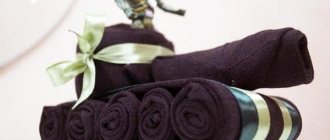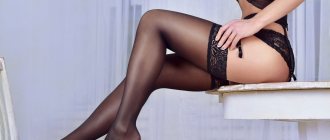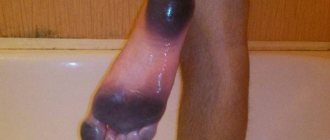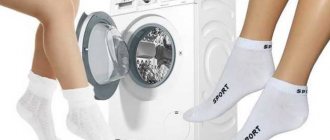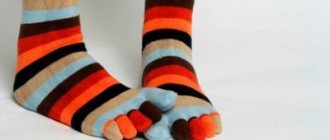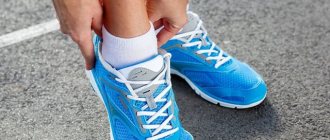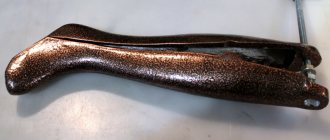Socks are an indispensable attribute of a man's wardrobe. These simple fabric products come in dozens of colors and are made from a variety of materials. Each of them has its own characteristics and functionality, which makes it possible to choose the optimal model for each specific case.
According to buyers, the popularity of models for everyday wear is explained by their ease of use and the ability to be used in combination with different types of shoes. In addition, such products have many advantages and a minimum of disadvantages, and are also sold in any online clothing stores.
Roskoshestvo will tell you which socks are better
As a 2016 Roskachestvo study showed, the situation on the men’s socks market in Russia is ambiguous.
The most painful point is the dominance of counterfeit products. Almost 65% of products were named as such. But still, the overwhelming number of violations among manufacturers of men's socks relates exclusively to labeling, while the majority of products, according to the results of Roskachestvo research, comply with sanitary and hygienic standards and quality requirements. 10 out of 35 examined samples were recognized as high-quality goods, 6 of which were confirmed to be of domestic origin. After conducting a technical audit of enterprises, including determining the level of localization of production, a decision will be made to award these goods with the Russian Quality Mark. In 2022, Roskachestvo examined men's socks from the seven most popular brands: “Red Vetka”, “Wear Yours!”, Akos, Askomi, In Extenso, O'Stin, Senator. It should be noted that six manufacturers have changed sock models. Accordingly, experts explored new models. The previous sock model remains with the Senator brand, which has been re-researched.
Armani
Giorgio Armani is a famous Italian fashion designer. In 1975, he founded a company producing clothing as well as other accessories. The brand is famous for its ability to produce high-quality and stylish items. Today Armani is a luxury clothing that is often purchased for special occasions and business meetings.
A sense of style, as well as experience in sourcing quality materials, allows the company to produce clothes that are suitable for everyday walks. The socks are especially worth noting, as they have become a symbol of changes in the company's approach.
The company remains true to itself, so even in socks it tries to find interesting solutions. The clothes look very nice. These socks are best suited for daily trips to work, as well as special occasions.
The company prefers to use dark shades. There are also white options. But you definitely won’t find colored socks. In order to make the models more interesting, many of them have small and simple patterns added in a modern minimalist style.
STANDARD OF THE RUSSIAN QUALITY SYSTEM
The standard of the Russian quality system for men's socks, in comparison with the current GOST, sets for potential recipients of the state Quality Mark increased requirements for such a quality indicator as color fastness to dry friction. With regard to safety, the Roskachestvo standard has tightened the most important indicators - the toxicity index and hygroscopicity of socks. The required level of production localization for awarding the Russian Quality Mark is at least 80% of the cost of the product.
The requirements of the Roskachestvo standard are voluntary and are not mandatory for the manufacturer. If the product meets the advanced requirements of the Roskachestvo standard, the manufacturer receives the right to apply for product labeling with the Russian Quality Mark.
In 2016, as part of a comprehensive study by Roskachestvo, the quality and safety parameters of men's socks from the most popular brands among Russians were studied, including both consumer goods costing from 27 to 999 rubles, and luxury brand goods, the cost of which was up to 2,500 rubles per unit goods. All products studied are products from sizes 41 to 46. Most of the socks (26 samples) were made in Russia. The rest of the goods were manufactured at enterprises in Belarus, China and Ukraine. Each sample was examined for 11 quality and safety parameters.
Abrasion resistance
Perhaps the most important characteristic of socks for men is their resistance to wear and tear, mainly abrasion. The strong half of humanity prefers to buy this “consumable” wardrobe element as rarely as possible, and better - in bulk at one retail outlet. Therefore, high-quality socks should have high wear resistance. The parameters of the fabric’s resistance to abrasion along the plane of the footprint and the front parts of the sock are largely responsible for this. The last segments - the heel (back of the toe) and toe (front of the toe) - are the most worn areas of the product.
Studies have shown that all presented samples are quite resistant to abrasion over their entire surface. Separately, products under the trademarks Etalon, ARKTUR, ASKOMI, AUTHENTIC, In Extenso were noted. These socks can withstand the longest and most grueling use.
FAQ
What color should the socks be?
+
The most common shades of mostly men's socks include black, navy blue, dark green and dark grey. These colors are considered classic and universal and go well with business suits, tracksuits, jeans, etc. Bright socks and patterned items are best used with informal or loungewear. They are also worn by women and children.
What types of socks are there?
+
Modern models are distinguished by their manufacturing method. Socks are produced on hosiery machines, cotton or fang machines. Depending on the equipment used, they have a distinctive seam in the back, toe compartments or reinforced toe and heel. In stores you can also find compression, classic, sports and protective socks (for example, waterproof or thermal).
Manufacturer information
When studying light industry products, special attention is paid to the study of product labeling.
Roskoshestvo has repeatedly identified products about which information was either too sparse or non-existent. Unfortunately, some manufacturers offer customers products whose labels do not indicate any information about the supplier or manufacturer of the product, or this information is not duplicated in Russian. This is a violation of the rights of consumers, who, according to the law, have the right to know everything about the origin of the product in order to address possible complaints directly. The “unknown” socks in this study were products under the DMDBS and ISKRA brands. Their label did not contain any mandatory production information at all. For ASKOMI and Lorenz products, for some reason the manufacturer did not indicate the size of the product. All these facts are violations.
Thin where it breaks
The “nose” of the sock is the area of the product that experiences the greatest impact of friction during operation. Therefore, holes on socks most often appear in the front part. In addition, in the toe section, a high-quality product should have a flat and durable seam. The requirements for these parameters are set by GOST and the Russian Quality System standard. In laboratory conditions, it was found that almost all of the tested products, in terms of the thickness of the toe seam, complied with the established standards. In products under the trademarks “OUR Product”, Karavan, Senator, the presence of rare seam stitches was revealed; In addition, in the socks “OUR product”, Karavan, this seam was considered too wide, with sparse stitches due to thick threads. The manufacturers of all three products on their packaging declared compliance with GOST, which was not confirmed during laboratory tests.
2022 test result
In socks “Wear your own!” and Senator experts identified the presence of rare seam stitches. In addition, in the products “Wear yours!” this seam was found to be too thick. Since the manufacturers of socks of both brands stated that they manufacture products in accordance with GOST, these discrepancies are a violation.
Color fastness
Usually a person wears socks for one day, after which they go into the wash. That is, in fact, socks spend more time in the laundry basket, washing machine and drying than under operating conditions. It is worth understanding that socks may change color when washed. The preservation of the original color of the socks during use and during subsequent repeated wet treatments determines the color stability parameter of the socks when exposed to washing. At the same time, we should not forget that socks that have changed their original color are not only unaesthetic and uneconomical, but in some cases also dangerous. The dye separated from the fabric can cause a severe allergic reaction on the foot. Fortunately, all samples presented in the study retained their color after washing.
By the way, along with the color fastness of the socks to wet processing, the samples were also tested for color fastness to sweat and dry friction. These tests yielded similarly optimistic results: all products met regulatory requirements. The best results in color fastness to the entire range of physical and chemical influences were demonstrated by socks under the Brest, Smolenskie, Collonil, and TOP trademarks.
Gucci
If you ask to name the most stylish, fashionable and expensive clothes, they will name you either Gucci or Louis Vuitton. Let's talk about the first one. The company was founded in Italy in 1921. As you know, Italian clothes always look very stylish and beautiful. Therefore, it is not surprising that Gucci began to set trends.
First of all, Gucci became famous thanks to outerwear. But the company has grown, so now the company is able to provide any things that are of interest to customers.
The socks are made of quality materials that help you move freely. They also do not tear even under heavy load. This makes such things not only beautiful, but also durable.
But the appearance of the models is more interesting. The company is not afraid to experiment, so it freely produces not only calm, but also bright models. Everyone can find an interesting set of socks for themselves. It is also worth paying attention to models with drawings. They have a very modern look and also look great in bright and bold looks.
Toxicity index
The production of any light industry products includes technological processes that actively use chemicals, and sometimes potentially dangerous compounds. In order to detect elements harmful to health, light industry products are examined according to the toxicity index parameter. However, socks are an exception in this case. The current technical regulations of the Customs Union (TR CU 017/2011 “On the safety of light industry products”) establishes the following requirements: for materials of products in contact with human skin, clothing of the first and second layers, the toxicity index determined in the aquatic environment must be from 70 up to 120% inclusive, in the air - from 80 to 120% inclusive, or there should be no local skin irritation. These requirements are mandatory. The interstate standard does not provide for any requirements for the toxicity of socks. The Roskachestvo standard in this regard sided with consumers and tightened the requirements for this quality indicator, establishing acceptable toxicity index values for socks from 70 to 110%. As laboratory tests have shown, the vast majority of products presented in the study, with the exception of two samples, met these increased requirements.
Calvin Klein
And the last company for today is Calvin Klein. The company was founded in the USA in 1968. They specialize in stylish, unisex clothing. Calvin Klein items are great for both men and women. The company gained its fame through the production of shirts, jeans and underwear.
They also initially produced socks. Things are expensive, but they look very beautiful. It is also worth noting that all things from this company are able to cope with any load (although they are usually not tested for this), because Calvin Klein selects special materials.
The socks include not only classic models for men, but also unisex ones. To do this, the company chooses either light shades or bright ones. You can also note special short models for those who want to comply with fashion trends.
On almost every model you can find the company name (or an abbreviation for it) of the company. A smart font can make things more interesting. And also the name, located in the most prominent place, significantly increases the prestige of the carrier.
Hygroscopicity
From the point of view of the current standardization system in the country, socks can be called a unique product. They are subject to minimum safety requirements. For example, one of the most important safety indicators for light industry products - hygroscopicity - is not assessed according to the CU TR for socks. In general, hygroscopicity determines how effectively a fabric absorbs and removes water vapor from the body. In the case of socks, which are essentially a layer between the foot and the shoe, not everything is clear. Here, the hygienic indicator of hygroscopicity will greatly depend on the quality of the shoes. That is, the foot can sweat both because of a poor-quality sock and because of poor-quality shoes. Nevertheless, the Roskachestvo standard has established more stringent requirements for the hygroscopicity of socks compared to TR CU 017/2011. This quality indicator was established similarly to the requirements for other first-layer clothing. During laboratory tests, it was found that the vast majority of the products tested met the most stringent requirements of the Roskachestvo standard, which means that foot hygiene will not be compromised when using these socks. In eight products, hygroscopicity turned out to be not the highest - such products cannot qualify for the Russian Quality Mark.
2022 Trials
The test results showed that of the seven brands, only Askomi products reached the requirements of the leading standard for this indicator.
Types of products
Before you look for where to buy socks and how much these products cost, you need to understand what types there are. There are a large number of classifications that divide this type of clothing according to different criteria. In this case, socks are most often sorted by size, season of use and material of manufacture.
Classification by material type:
- Synthetics (polyester, nylon, acrylic). Products of this type have a beautiful appearance and are easy to wash. In addition, they do not lose their shape even after several months of use and do not become dull. Among the disadvantages of synthetic materials is the rapid fatigue of the legs, which makes it possible to use them only during short walks.
- Cotton. Socks made from this natural material are considered one of the safest. They do not harm the skin of the feet and do not squeeze the fingers, which eliminates any discomfort. At the same time, such products quickly become dirty, are difficult to wash and do not retain heat. All these qualities make cotton models suitable only for the spring-summer period.
- Wool. Socks for men and children made from this material are ideal for the cold season. They have a high density, retain heat well and are combined with most winter wardrobe items. At the same time, woolen models are not suitable for narrow shoes and use in well-heated rooms.
- Silk. Such products are very expensive, but provide their owner with a high level of comfort. They are intended for use in spring-autumn transitional weather. They can also be worn on your feet in the summer.
- Cashmere. Models made from this natural material attract attention with their low weight, low thermal conductivity and high strength. However, they are expensive and require proper care.
- Linen. Naturalness and safety for health are the main advantages of men's socks (MS) made from this material. In addition, they are easy to wash, have a beautiful appearance and can be combined with most wardrobe items. The only drawback of linen is poor dyeability, which is why buyers are limited in their choice of color options.
- Viscose. This material is obtained from natural raw materials by artificial means. It is perfect for making MNs, as it has softness, lightness and a texture pleasant to the touch. In addition, it does not electrify and does not fade when washed. The only disadvantage of viscose is the likelihood of deformation upon contact with moisture.
- Modal. Products made from this new generation material are expensive and are not sold in all stores. Among their advantages are lightness, environmental friendliness, beautiful appearance and strength. However, modal models may shrink after washing.
- Bamboo. MNs from this fabric have a hypoallergenic effect and natural bactericidal properties. They also have an attractive appearance and do not lose their shape during washing. The only disadvantage of bamboo products is their high cost.
Composition of the offense
The vast majority of consumers prefer fabrics made from natural fibers and threads to fabrics made from chemical fibers, and socks are no exception in this regard. Synthetic threads and fibers, based on the characteristics of the product’s operation, can be both unhygienic and harmful to health. Nevertheless, socks, like any other light industry product, are at risk: most often it is in the clothing category that a large number of counterfeit products are found.
Additional ambiguity in the identification of socks based on the correspondence of the actual raw material composition to that indicated on the label is introduced by inaccurately formulated requirements for indicating the raw material composition of socks in the current regulatory documentation. In terms of determining the actual composition of socks, laboratory studies have shown a rather pessimistic picture. In 22 of the 35 products presented in the study, the declared composition differed from the actual one. Moreover, only one product (BITEX) had a composition that was radically different from what was indicated on the packaging: instead of 85% cotton, the composition actually contained 98% polyester. It is worth saying that this stage of the study allows for a fairly large error (7%) and analysis of the possible correspondence of the actual data to those indicated on the label. That is, for example, the actual cotton content of 73% while the declared 80% would be legally completely legal. However, it was not possible to establish compliance with actual data and information on the raw material composition on the labeling for socks under the following trademarks: Grand, “OUR Product”, “Wear Yours!”, “Noskof”, “PINGONS”, “Etalon”, AKOS, ARAMIS , ART-SOCKS, ASKOMI, AUTHENTIC, BITEX, Burlesco, DMDBS, Felis chaus, ISKRA, Karavan, Lorenz, Modis, Pierre Cardin, Senator, TOP. Information about all identified violations was transferred to the control and supervisory authorities.
2022 Study Results
Manufacturers of socks of three brands indicated incorrect information about the composition of raw materials in the labeling. The label assures that the socks are made of 100 percent cotton. The study found that the actual fabric used to make the socks was 27.3% cotton and 72.7% polyester. The manufacturer Askomi indicated in the labeling 80% cotton and 20% polyamide, in reality - 68.0% cotton and 32.0% polyamide. Senator stated the fabric composition as 80% cotton and 20% polyamide, but in fact it is 40.9% cotton and 59.1% polyester. (In a previous study, experts also found that the stated composition of Senator socks did not correspond to the actual one, that is, the manufacturer did not correct the errors).
Alsou RS51
Leg without folds.
These socks are notable for three things: they are made by the same factory as the socks for astronauts, they have almost the entire ankle knitted with an elastic band, and there are no folds at the ankle. We bought them at a price of 128 rubles per pair.
The purchase took place in the spring, but we still haven’t written a review. Looking ahead, let’s say that this model performed well: the socks did not tear, did not fray, and there are really almost no folds on the fold in the ankle area. But we believe that transparency in this very area can scare away the buyer.
Alsou RS51 socks. Image: bracatus.com
The black color is saturated, we deliberately brightened the photo, otherwise it would be difficult to see the weaving. Composition: 78% cotton, 14% polyamide, 8% polyurethane. They are knitted in Tatarstan.
That's all for now! Now you know how we spent the summer - we tested socks

